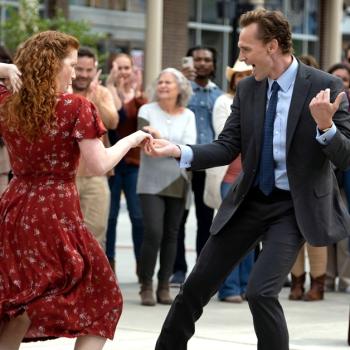 Will is to grace as the horse is to the rider. — St. Augustine
Will is to grace as the horse is to the rider. — St. Augustine
In the darkest hours of American history, sometimes God sends us a horse.
During the horrors of World War I, there was awkward, angular Exterminator, nicknamed “Old Bones,” who took the place of his celebrated training partner, Sun Briar, to win the 1918 Kentucky Derby as a 30-1 longshot.
In the wake of World War I came the celebrated and beloved “Big Red,” Man O’War, who beat Canadian-bred Sir Barton by seven lengths in a 1920 match race that became the first horse race to be filmed in its entirety.
During the Great Depression, there was the small but mighty Seabiscuit, who overcame bad knees and persistent lameness to, in 1938, beat War Admiral (sired by Man O’War, who was also Seabiscuit’s grandsire) in the “Match of the Century” at Pimlico Racecourse in Maryland. With that win, he gave hope to a suffering nation.
In the midst of World War II, the legendary Citation unleashed a three-year-old season, the likes of which had never been seen. Through 1948, he won 19 of 20 races, at 10 different tracks and in seven different states, culminating in the last Triple Crown win until …
As the Vietnam War crawled to an end, and the American economy began a long slide into recession and stagflation, and the Watergate scandal ripped the country apart, the second horse to bear the name “Big Red” blazed through the 1973 Triple Crown. The glorious Secretariat electrified the nation, never more so than in his staggering Belmont win.
Then in 2015, as America continued to trudge through a slow economic recovery and its endless wars against Islamist terrorism in the Middle East and around the globe, came the first Triple Crown champion in 37 years. Owned by an Orthodox Jewish American businessman born in Egypt, American Pharoah (with “pharaoh” accidentally misspelled) ran the last quarter-mile of the Belmont even faster than Secretariat.
BTW, the news came out a couple of days ago that American Pharoah’s full brother, St. Patrick’s Day, is set to make his debut today, Aug. 20, in a race for other first-timers at Del Mar in Southern California (as I type, the race has not yet been run).
UPDATE: He didn’t win, but he did come in second.
On Monday, Aug. 21, America will see its first total solar eclipse since 1979, with the sun being entirely obscured by the moon in an arc across the whole U.S., from Oregon to South Carolina.
More than a century before the previous total eclipse in 1918, a chestnut horse was foaled in 1814 in upstate New York named American Eclipse (he was red, but at 15 hands, 1 inch high, he wasn’t “big” by Thoroughbred standards). America was still in the midst of the War of 1812 against Britain and Canada, on land and at sea.
In the late summer of 1814, British redcoats descended on the newly built capital of Washington, D.C., and captured it. Dolly Madison, wife of President James Madison, refused to abandon the White House until she was sure the portrait of George Washington was safely removed.
And lucky she did, since the British torched both houses of Congress (including the Library of Congress) and, after eating dinner at the president’s table (left behind when the inhabitants fled), they set the White House on fire.
Also burned were the Treasury, State Department and the Department of War. Only the Patent Office was saved, when its director, William Thornton, rode out to beg the British soldiers not to behave “like the Turks in Alexandria.”
With a nation struck at its heart and demoralized, American Eclipse (named for the great British horse Eclipse of the mid-1700s) grabbed headlines during a six-year career. Mind you this was at a time when races were in heats, some three to four miles in length.
American Eclipse defeated a top mare, Lady Lightfoot (who raced to 11, and out of whom he had a great racing daughter, Black Maria), and twice beat another top horse of his day, Sir Charles.
In 1823, with Andrew Jackson and Aaron Burr in attendance, the nine-year-old American Eclipse, representing the North, ran at the Union Course on Long Island in a match race against three-year-old Henry, representing the South.
American Eclipse ran three four-mile heats against Henry, who carried lighter weight. He lost the first by a length, but won the last two and the race overall.
Retired to stud in New York, then Virginia and finally Kentucky, American Eclipse sired many great colts and fillies and lived to the ripe old age of 33. He died in 1847, a little less than two decades before the beginning of the Civil War his match race prefigured.
What does American Eclipse say to us today? He says that valor, honor and courage best serve purity of purpose; that not all success comes in youth; that strength, experience and endurance can win the race; and that old rivals can come together to produce something new.
May this American eclipse mark a new beginning, uniting the nation under its founding principles, as imperfectly as we have often lived them out. Because, unless the finish line is far and hard to reach, why run the race?
Image: Edward Troye (American, 1808 – 1874), American Eclipse, 1834, 1843, oil on canvas, National Sporting Library & Museum, Gift of Mr. George L. Ohrstrom, Jr., c. 1974
Don’t miss a thing: head over to my other home, as Social Media Manager at Family Theater Productions; and check out FTP’s Faith & Family Media Blog.













